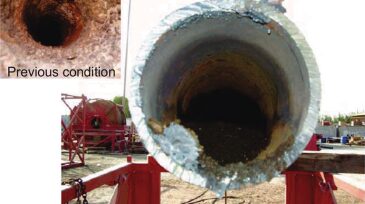Oilfield chemistry
Field examples from the Bakken Shale and Permian Basin illustrate the benefits of deploying polymer-coated and uncoated scale inhibitors in unconventional wells.
New strategies for protecting metal infrastructure emerge as operators fine-tune a corrosion threat screening process and develop a new method for tracking inhibitor effectiveness.
Interfacial tension keeps oil and water separate by resisting the mixing of their molecules at the surface. Learn how industry experts measure this force to diagnose fluid behavior.
-
The removal of mineral scale in the oil field is typically perceived as a somewhat nonscientific discipline.
-
Sour gas is being produced from a number of carbon-steel-completed wells in the US, Canada, France, and Saudi Arabia.
-
This work introduces sodium gluconate as an efficient and environmentally friendly iron-chelating agent.
-
This feature takes a look at the work being done by companies to improve corrosion inhibitor fluids and inhibition techniques for offshore projects.
-
The development and upgrade of mature facilities is ultimately driven by the significant shift in the composition of the arrival fluids, mainly the increasing water cut and solids production.
-
Ferrous sulfide (FeS) precipitation increases during shale-gas and -oil production because of increased biologically and thermally induced sulfide production. Although FeS scale is abundant, little is understood about its precipitation and inhibition properties.
-
The gas-producing carbonate zones of the Ghawar field in eastern Saudi Arabia have been affected by extensive iron sulfide (FeS) scale deposition, reducing overall gas production and increasing risks during well interventions.
-
This paper describes various sulfide inhibitor-testing techniques that have been applied to candidate products for the management of zinc sulfide (ZnS) and lead sulfide (PbS) in a gas/condensate field with a known relatively severe ZnS/PbS scaling problem.
-
Critical to success is the accurate testing in the laboratory that best approximates field conditions.
-
Mixed carbonate-/sulfide-scale problems have been reported when water is produced from carbonate reservoirs. This study presents interactions of lead sulfide and zinc sulfide coprecipitating with calcite.












